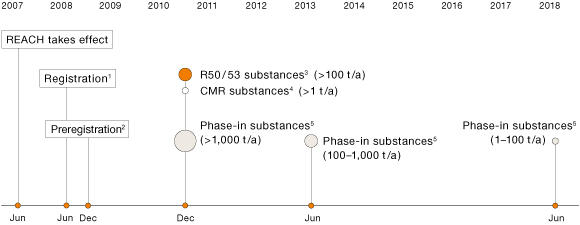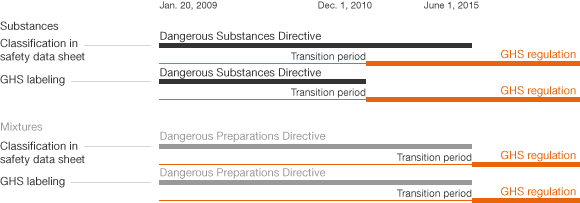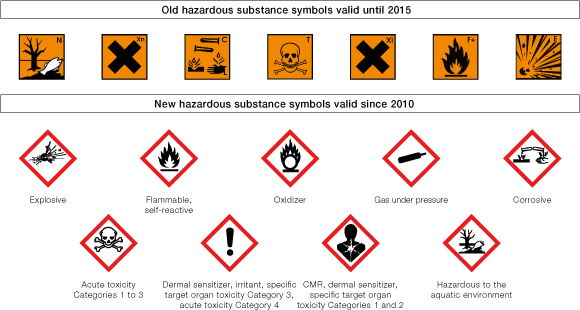Product Safety
WACKER provides information on the safe use of its products and is continually working to prevent or reduce the use of substances which are harmful to human health or the environment in products. We pursue this aim in a number of ways:
- We try to replace harmful substances with alternatives.
- If no alternative is available, we restrict the sale of products containing harmful substances to commercial and industrial customers wherever possible.
- We develop innovative alternatives to conventional products containing harmful substances.
As a guide for our product developers, we maintain a list of about 500 substances that are no longer to be used at WACKER. They include not only forbidden and restricted chemicals (e.g. substances included in REACH Appendices XIV and XVII), but also substances that are the subject of public controversy or classed as undesirable by individual companies. We avoid substances that are on the European Chemicals Agency’s List of Substances of Very High Concern (SVHC).
Product Information
We ensure that there are no risks to health or the environment from any of our products, provided they are used correctly. We continually update our product information and constantly revise our risk assessments to include the latest findings about safety aspects and environmental impact. We also adapt our risk assessments to take account of new findings that must be incorporated into substance safety reports according to REACH.
Product Advertising
When advertising our products and services, we make sure that all the data contained in, for example, our brochures is verifiable, is stated with precise, legally compliant terminology,and wording that reflects current scientific knowledge. Below are some examples of our advertising that refers to sustainability for construction-sector products:
- We discuss energy efficiency in a video on external thermal insulation composite systems.
- In the “Sustainability Is Feasible: Facades” brochure, we illustrate how our products for the construction sector contribute to saving energy costs and building materials and avoiding emissions.
- In an advertisement for GENIOSIL® WP, we show that this hybrid polymer can be used to formulate waterproofing products without the addition of solvents, plasticizers or tin catalysts.
Safety Data Sheets
Only some 40 percent of WACKER products require safety data sheets by law. We go beyond these requirements and compile data sheets for all our sales products – not just for those classified as hazardous substances. WACKER issues over 75,000 safety data sheets in up to 35 languages.
WACKER publishes a wide range of information in its data sheets to ensure that substances and mixtures are handled correctly:
- Designations of substances and mixtures
- Potential risks
- Composition and information about ingredients
- First-aid measures
- Fire-fighting measures
- Response in the event of accidental release
- Handling and storage
- Restriction and monitoring of exposure / personal protective equipment
- Physical and chemical properties
- Stability and reactivity
- Toxicological data
- Environmental data
- Notes on disposal
- Transportation guidelines
- Legislation and other information
Nanomaterials
So far, there is no standard definition for the term “nanomaterial” and there are no standardized specifications for the analysis methods used to classify substances as nanomaterials. For the identification of nanomaterials, WACKER refers to the EU recommendation on the definition of these materials (2011/696/EU), which is based on ISO TC 229 “Nanotechnologies.”
Nanomaterials can possess innovative properties that significantly enhance products and processes. What is true of all chemical substances also applies to nanomaterials: it is important to take account of the risk to production staff and users through inhalation, or dermal or oral exposure. In addition, effects on health that may result from the uptake of nanomaterials in the form of particles, fibers or platelets are under discussion. (Source: “Empfehlung für die Gefährdungsbeurteilung bei Tätigkeiten mit Nanomaterialien am Arbeitsplatz” (recommendation issued by the BAuA (German Federal Institute for Occupational Safety and Health) and the VCI (German Chemical Industry Association) for the analysis of hazards during activities involving nanomaterials at the workplace.)
All the nanomaterials that we produce or use have been recorded and their risks assessed. Most of them are nanostructured – a classification that includes materials whose internal structures are nanoscale (between 1 and 100 nanometers), but whose external dimensions are greater than the nano-range. These nanostructured products include HDK® pyrogenic silica, a powder used as a thickener, filler or flow enhancer. The physicochemical properties of the HDK® product group have been examined in detail. Here, we collaborated with external scientific institutes. Extensive toxicological, eco-toxicological and epidemiological data exist.
In collaboration with the Technical University of Dresden, we validated analytical techniques to measure nanoparticles. We investigated the potential release of nanoparticles at our labs and, in 2010, at our HDK® production facility, as well. The results showed no relevant release of HDK® nanoparticles. We are continuing our work on this topic and are paying particular attention to nano-specific regulatory requirements (e.g. national nanoproduct registers and specific REACH requirements), which we implement accordingly.
REACH
REACH legislation, which came into force in 2007, governs the registration, evaluation, authorization and restriction of chemicals within the European Union. Comprehensive data are gathered through REACH, which imposes high requirements on the manufacturers, importers and users of chemical products. On the European market, all substances used or imported in annual quantities exceeding one metric ton must be registered and evaluated. The scope of evaluation work is largely determined by the quantity of material produced or imported and the expected risks. Particularly high-risk substances are subject to regulatory approval. REACH compliance costs WACKER a total of €30 million.
153 Registration Dossiers Submitted as Part of REACH
As of 2008, we are obligated to register all substances produced in Europe – and toxicologically classify their properties – if annual quantities exceed one metric ton. The exact conditions of use must be taken into account. By June 2013, WACKER had submitted 153 registration dossiers to the European Chemicals Agency (ECHA). This includes 67 registration dossiers for substances between 100 and 1,000 metric tons a year, the registration deadline of which expired on May 31, 2013. As part of the normal REACH procedure, the ECHA still requires additional information to be provided on dossiers submitted during the first phase (2010).
By the end of 2012, together with the EU members’ regulatory bodies, the ECHA had identified 138 “substances of very high concern” for people and the environment as candidates for authorization. WACKER has only been marginally affected to date, with only a few purchased substances, and none of its own.
Since 2007, WACKER has been in close contact with its suppliers regarding their preregistrations for REACH, registrations that have already been made and those planned for the coming years. To obtain authoritative information, we systematically ask our suppliers about their current status – including about the use of substances and mixtures. We will continue with these inquiries beyond the final REACH registration deadline in 2018.
REACH demands extensive information about the properties of chemical products – which necessitates an increase in mandatory animal testing. WACKER makes every effort to avoid such testing and only performs ECHA-required tests. Whenever possible, we use recognized alternative methods, such as in-vitro tests. We classify substances with similar properties into groups for testing and work within REACH consortia to exchange scientific data with other companies.
European Chemicals Agency’s REACH Schedule: Deadlines for Submitting Dossiers

1 New substances > 1 metric ton / year
2 Phase-in substances > 1 metric ton / year
3 R50 / 53 substances: “highly toxic to aquatic organisms” and “may have long-term harmful effects in bodies of water”
4 CMR substances: carcinogenic, mutagenic or toxic to reproduction
5 Phase-in substances: predominantly old substances listed on the EINECS inventory (European Inventory of Existing Commercial Chemical Substances on the market before 1981)
GHS
GHS (Globally Harmonized System of Classification and Labeling of Chemicals) is a United Nations initiative for harmonizing the classification and labeling of hazardous substances. It is up to individual countries to decide whether to adopt the system, and, if so, which modules to accept, and when. GHS was introduced to Europe in January 2009 with the European Regulation on the Classification, Labeling and Packaging of Substances and Mixtures (the CLP Regulation).
European Union’s GHS Timetable

We started adapting our safety data sheets to meet international GHS requirements back in 2007 and are continuing this process in line with the GHS implementation deadlines set for the countries to which we supply products. Since the introduction of some elements of the system is optional, GHS implementation differs from country to country. According to experts, this runs counter to the idea of global harmonization, and means that a specific product’s classification can vary from country to country.
| Download XLS |
|
GHS Introduction in Selected Countries and Regions | ||||||
|
|
|
|
| |||
|
Country/ |
Change of |
Change of |
Substances/ | |||
|
|
|
|
| |||
|
Australia |
January 2017 |
January 2017 |
Substances and mixtures | |||
|
Brazil |
February 2011 |
February 2011 |
Substances | |||
|
China |
May 2011 |
May 2011 |
Substances and mixtures | |||
|
Europe |
December 2010 |
December 2010 |
Substances | |||
|
Japan |
January 2011 |
December 2006 |
100 special substances | |||
|
Mexico |
July 2011 |
July 2011 |
Substances and mixtures, | |||
|
Switzerland |
December 2012 |
December 2012 |
Substances | |||
|
Singapore |
December 2010 |
December 2010 |
Substances | |||
|
South Korea |
July 2010 |
July 2010 |
Substances | |||
|
Taiwan |
January 2009 |
January 2009 |
Substances and mixtures | |||
|
Turkey |
Potentially 2015 |
Potentially 2015 |
Not yet specified | |||
|
USA |
June 2015 |
June 2015 |
Substances and mixtures | |||
By 2015, all our mixtures will have been reclassified pursuant to EU GHS, too (7,000 mixtures). The ECHA has set up a central classification and labeling register for hazardous substances. We have been registering all relevant substances here since 2011.
GHS implementation costs WACKER around €3 million. For us, this system switchover means that every product must be checked, reclassified and relabeled. Within just a few years, we must reclassify tens of thousands of substances and mixtures, change all safety data sheets and redesign hazardous substance labels to take account of the new symbols and hazard information.
GHS affects any employee involved with hazardous substances. It impacts not only production and laboratory workers (who handle GHS-labeled chemicals on a daily basis), but also safety officers (who prepare SOPs). Furthermore, employees who label vessels, piping and equipment have to know and be fully sensitized to the new hazard symbols. WACKER provides its employees with online training and a wide range of informative literature on GHS. The online GHS training is currently mandatory for all employees in Germany who work with chemical substances.
Overview of Hazard Symbols in the EU

The GHS Regulation on the Classification and Labeling of Chemicals has already replaced the previous orange hazard symbols for pure substances in Europe with new symbols consisting of a white diamond in a red frame.
GPS
The ICCA (International Council of Chemical Associations) has developed the “Global Product Strategy” (GPS), which contains rules for the assessment of the properties of chemicals and on how to provide information on their safe use.
In Europe, most GPS requirements are satisfied by the European chemicals regulations REACH and CLP (Classification, Labeling and Packaging of Substances and Mixtures). GPS takes the idea of easily available and understandable information on the properties, risks, protective measures and safe use of chemicals especially seriously and commits manufacturers to publishing so-called GPS Safety Summaries – descriptions written in layman’s terms on the safe and environmentally sound use of chemicals, available to anyone via the internet.
With its GPS chemicals portal, the ICCA gives the public access to information for the responsible handling of chemicals. So far, we have published 41 GPS Safety Summaries in the ICCA’s GPS chemicals portal for the substances we have registered with the ECHA.